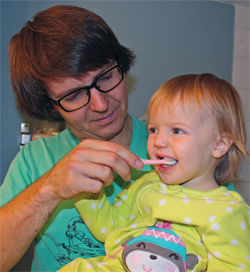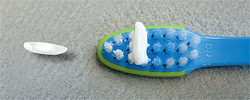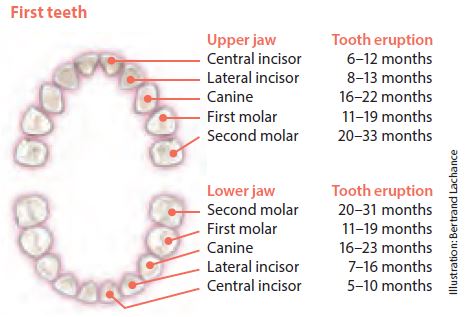Baby's teeth
![]() Don’t immediately assume that your baby’s fever, diarrhea, and red bottom are related to teething. Even if these symptoms occur at the same time, they are often caused by something else. For more information, see Fever, Diarrhea, and Redness on the bottom (diaper rash).
Don’t immediately assume that your baby’s fever, diarrhea, and red bottom are related to teething. Even if these symptoms occur at the same time, they are often caused by something else. For more information, see Fever, Diarrhea, and Redness on the bottom (diaper rash).
Your baby’s teeth start to form during pregnancy. At birth, she has 20 baby teeth, or primary teeth, that are still growing under the gums.
The formation of baby teeth and permanent teeth is influenced by diet in early childhood and by the mother’s diet during pregnancy.
Teething
Teeth grow gradually until they break through the gums. It is known as tooth eruption.
Baby teeth generally appear at around 6 months. But they can come in earlier or later, even as late as 12 months. The lower front teeth (incisors) usually break through first.
Teething may go unnoticed or may cause discomfort. When your baby is teething, she may drool more and feel the need to chew on something.
Your baby may also have red or irritated skin on the face and may fret more than usual or refuse to eat.
In some babies a blue swelling (known as an eruption cyst) appears on the gum up to two months before the tooth breaks through. This cyst usually needs no treatment.
What to do during teething?
![]() Teething necklaces, syrups, and gels pose serious risks to your baby’s health.
Teething necklaces, syrups, and gels pose serious risks to your baby’s health.
If necessary, give your baby a clean washcloth soaked in cold water or a teething ring. You can cool the teething ring in the refrigerator, but don’t freeze it: your baby could injure her mouth.
You can also rub her gums with a clean finger.
Give her acetaminophen, if needed (see First choice: acetaminophen).
If your child is in serious discomfort, contact a health professional. You can also call Info-Santé at any time by dialing 8-1-1.
Products to avoid
Various products are available to relieve the discomfort of teething. However, they have not been shown to be effective and can be dangerous:
- Teething necklaces: Babies can choke on the wooden beads or other parts of a teething necklace, or can strangle themselves with it.
- Teething syrups and gels: These products contain an ingredient that can increase the risk of developing a serious blood condition. They also increase the risk of choking.
- Natural and homeopathic health products (e.g., belladonna): The exact contents of these products are not always clearly indicated on the packaging.
- Teething biscuits: These products do not relieve your baby’s discomfort. What’s more, they contain sugar and can therefore cause tooth decay (see Tooth decay).
- Certain pieces of raw fruit or vegetables can also be a choking hazard if given to baby to chew on (see Choking risk: Be extra careful until age 4).
Brushing

![]() As soon as the first teeth appear, brush them at least twice a day. Brushing before bed is the most important time to brush.
As soon as the first teeth appear, brush them at least twice a day. Brushing before bed is the most important time to brush.
Photo: Anne-Marie Turgeon
Even before the first tooth appears, you can gently rub your baby’s gums with a clean, moist washcloth. This cleans your baby’s mouth and gets her accustomed to the brushing to come.
As soon as the first tooth starts to show, start brushing at least twice a day using fluoride toothpaste. Fluoride toothpaste helps prevent cavities.
Before bed is the most important time to brush your baby’s teeth. Ideally, a toothbrush should be the last thing to come in contact with your baby’s mouth before bedtime. There is less saliva in your baby’s mouth when she’s sleeping, which means tooth decay can develop and progress more easily.
If your child wants to brush her teeth herself, encourage her, and then do a final brushing. Since children love to imitate, you can also brush your teeth at the same time.
Toothbrush
- Use a children’s toothbrush with soft bristles. Change it as soon as the bristles start to bend.
- Rinse the toothbrush after every use.
- Let it air dry upright. Do not put a cap on it.
- To prevent the spread of germs, make sure it doesn’t touch other toothbrushes.
- Make sure your child has her own toothbrush and doesn’t share it with anyone.
Toothpaste

![]() Use only a small amount of fluoride toothpaste: the size of a grain of rice is enough
Use only a small amount of fluoride toothpaste: the size of a grain of rice is enough
Photo: Gouvernement du Québec, 2019
As soon as you start brushing your child’s teeth, you can use the toothpaste of your choice as long as it:
- Contains fluoride, an effective protection against cavities.
- Is recommended for children under 6.
Since children tend to swallow toothpaste, use only a very small amount, about the size of a grain of rice.
To prevent children from ingesting too much toothpaste, store it out of their reach.
Sugar
Sugars occur naturally in fruits, juices, and milk (e.g., breast milk, commercial infant formula, and cow’s milk). Sugar is often added to drinks, food, and drugs for children.
The more your child’s teeth are in contact with sugar, the more your child risks developing cavities.
Baby bottle
Prolonged contact between your child’s teeth and her bottle contain
Don’t let your baby drink from or suck on her bottle for long periods of time. Don’t let her sleep with or carry around a bottle or sippy cup containing juice or any other liquid except water.
If your baby has gotten into one of these habits, gradually dilute the contents of the bottle or cup with water until it contains nothing else. To reduce the risk of tooth decay, it’s best to wean her off the bottle when she’s about a year old.
Pacifier
Don’t dip your baby’s pacifier in honey, corn syrup, or any other sweet product.
Tooth decay
Tooth decay (also known as cavities or dental caries) can occur when your child is small, even before age 2. Once it appears, it can quickly get worse. The decay is caused by bacteria producing acid that attacks the structure of the tooth. It can cause pain and may interfere with your child’s sleep or feeding.
If you see dull white, yellowish, or brownish stains on your child’s teeth, it is advisable to see a dentist or dental hygienist. It could be the start of tooth decay. It’s important for the health of young children to have tooth decay treated, even though they will eventually lose their baby teeth.
Visits to the dentist
It’s a good idea to schedule a first visit to the dentist for your child after her first birthday.
Régie de l’assurance maladie du Québec covers the cost of dental exams and some treatments for children under 10.



